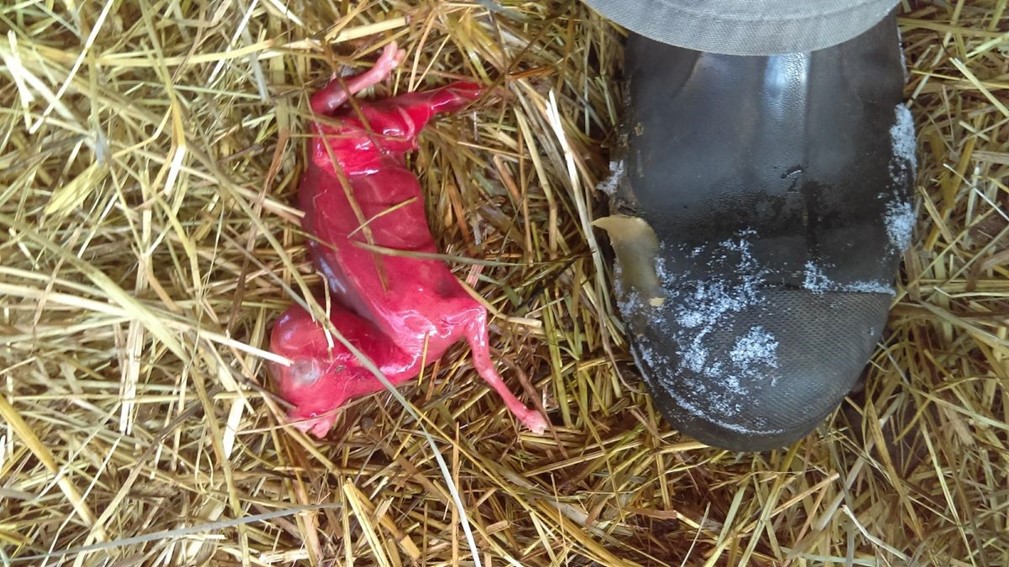Not all lambs make it all the way from conception to birth. On occasion we see a litter where some are full term healthy lambs, but there is also a mummy or a partially formed lamb. Deciding how to enter data in these cases can be confusing. But here are some guidelines to help you decide how to enter  these lambs.
these lambs.
Keep in mind that the birth type of a lamb is used in adjustments for birth weight. A single lamb that weighs 10 pounds will end up with a lower birth weight EBV than a triplet lamb with a 10-pound birth weight (everything else being equal) because a triplet has to share resources in the womb with two other lambs, so you would expect it to be smaller. A ewe’s NLB (number of lambs born) and NLW (number of lambs weaned) EBVs are calculated from the data that you enter for birth type and rear type for her lambs, not how many lambs she has that have data entered.
A lamb that is coded as DAB will not generate any fees and you will not get any EBVs for this lamb. You are entering this lamb to make sure its siblings have more accurate EBVs than what they would have if you did not enter this lamb.
Here is a sample NSIP ID for a DAB lamb 6401552024DAB001
- The number starts with your flock ID, 640155 for my flock
- Then the year that the lamb is born in 2024 in this case
- DAB instead of what you normally put in this field
- Then a number (you can have more than one DAB lamb per year. In my flock, the first DAB lamb of the year will be 001
Below are a few birth scenarios and the recommended way to enter the resulting lamb. BT is birth type and RT is rear type. Be sure to weigh dead lambs and enter a birth weight for DAB lambs. All these scenarios assume that the ewe is raising all the live lambs.
Scenario 1:
Two full term lambs are born and you find a small mummy in the placenta that is passed afterwards.
For the live lambs: BT=2, RT=2
For the mummy: Do not enter it at all.
You are just pretending that the mummy was not there because it did not really deprive its siblings of resources.
Scenario 2:
Two full term lambs are born and a third lamb that is ¾ the size of the live lambs, but it does not have hair and was born dead.
For the live lambs: BT=3, RT=2
For the dead lamb: DAB NSIP ID with BT=3, RT=0
This lamb deprived its two full term siblings of resources for more than half the pregnancy.
Scenario 3:
Three full term, normal lambs are born, but one of them was born dead.
For the live lambs: BT=3, RT=2
For the dead lamb: DAB NSIP ID with BT=3, RT=0
This lamb deprived its two full term siblings of resources for the whole pregnancy
Scenario 4:
Three full term live lambs are born, but one of them dies at two days old.
For the live lambs: BT=3, RT=2
For the lamb that died: DAB NSIP ID with BT=3, RT=0
Even though this lamb was born alive, it died so close to birth that it did not really have time to deprive its siblings of resources after birth. If you enter your lambs in NSIP right at birth, be sure to go back and adjust the RT of the surviving lambs if one of the siblings dies.
Scenario 5:
You were unfortunate and mosquitoes carrying Cache Valley Fever (CVF) were around during your ewes’ early pregnancy. You are seeing more ewes that are open this year, more ewes only have single lambs and you have some ewes that are delivering preterm or full-term malformed lambs. Some ewes have one or more normal lambs as well as malformed lambs. You worked this up with your vet and know that your flock was affected by CVF this year.
CVF causes abortion in ewes that are infected before day 32 of pregnancy, malformed lambs in ewes that are infected between day 32 and 37 of pregnancy, and no disease at all in ewes that are infected after day 37 of pregnancy. This is a complicated scenario as the ewes that were less than 37 days pregnant were affected by a disease with significant effect on their NLB while the ewes that were more than 37 days pregnant at that time were not affected at all.
Ideally the affected ewes should be placed in a separate contemporary group as they had a significantly different “treatment” applied to them than the unaffected ewes. However, if your flock is small. breaking up your ewes into different contemporary groups can put you in a situation where your EBVs are less accurate because your contemporary groups are too small.
In this scenario, malformed lambs that appear to have died during the first half of pregnancy (small) should not be entered at all and the birth type of its siblings entered as if the malformed lamb was not there. Malformed lambs that are full term or appear to have died during the second half of pregnancy should be entered as DAB and they should be included in the BT of their siblings.
Remember, if you have any questions or concerns about how to apply this in your flock, Rusty Burgett is only a call or an email away if you have any questions about NSIP data entry.
Phone 515-780-8850
Email info@nsip.org
By: Isabel Richards, EAPK Communications Committee
![]()


